
Understanding the mechanics of an open end mutual fund a bit better. Created by Sal Khan.
- Subject:
- Economics
- Social Science
- Material Type:
- Lesson
- Provider:
- Khan Academy
- Provider Set:
- Khan Academy
- Author:
- Sal Khan
- Date Added:
- 07/15/2021

Understanding the mechanics of an open end mutual fund a bit better. Created by Sal Khan.

Basic difference between traditional open market operations and quantitative easing. Created by Sal Khan.
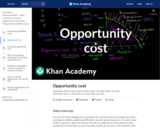
Opportunity cost is the value of something given up to obtain something else. In this video, we explore the definition of opportunity cost, how to calculate opportunity cost, and how the PPC illustrates opportunity cost. Created by Sal Khan.
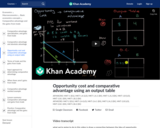
In this video, we use the PPCs for two different countries that each produce two goods in order to create an output table based on the data in the graph. We then use the output table to determine the opportunity costs of producing each good. Finally, we determine which country has a comparative advantage in each good.
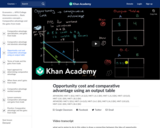
In this video, we use the PPCs for two different countries that each produce two goods in order to create an output table based on the data in the graph. We then use the output table to determine the opportunity costs of producing each good. Finally, we determine which country has a comparative advantage in each good.
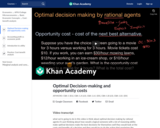
A rational agent considers all costs, including explicit and implicit costs, when deciding whether or not to undertake an action. In this video, learn about how opportunity costs represent the cost of the next best alternative.
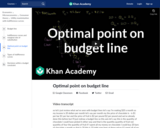
Using indifference curves to think about the point on the budget line that maximizes total utility. Created by Sal Khan.

Using some basic calculus to show that marginal revenue has twice the slope of the demand curve for a monopolist. Created by Sal Khan.
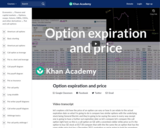
In this video we explore how aspects of an option's expiration affect the option's price. Created by Sal Khan.

Examines theory and research on the relationship of organizations to each other and to their economic, political, and social environments. Classic and contemporary approaches to complex social systems, the dynamics of inertia and change, the role of legitimacy, and the production of change as an intended or unintended consequence. Considers the relative roles of voluntarism and determinism in the pursuit of organizational agendas and in the shaping of organizational environments, for example, with respect to changing employment relationships and environmentalism. Primarily for doctoral students. The goal of this doctoral course is to familiarize students with major conceptual frameworks, debates, and developments in contemporary organization theory. This is an inter-disciplinary domain of inquiry drawing primarily from sociology, and secondarily from economics, psychology, anthropology, and political science. The course focuses on inter-organizational processes, and also addresses the economic, institutional and cultural contexts that organizations must face. This is an introduction to a vast and multifaceted domain of inquiry. Due to time limitations, this course will touch lightly on many important topics, and neglect others entirely; its design resembles more a map than an encyclopedia. Also, given the focus on theoretical matters, methodological issues will move to the background. Empirical material will be used to illustrate how knowledge is produced from a particular standpoint and trying to answer particular questions, leaving the bulk of the discussion on quantitative and qualitative procedures to seminars such as 15.347, 15.348, and the like.
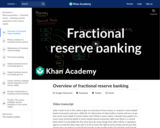
Big picture of how money enters circulation and how lending can increase the money supply. Created by Sal Khan.

A situation where the price to earnings ratio seems to not fairly price an asset. Created by Sal Khan.

Discussion of the price-to-earnings ratio. Created by Sal Khan.
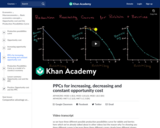
The shape of a production possibility curve (PPC) reveals important information about the opportunity cost involved in producing two goods. When the PPC is a straight line, opportunity costs are the same no matter how far you move along the curve. When the PPC is concave (bowed out), opportunity costs increase as you move along the curve. When the PPC is convex (bowed in), opportunity costs are decreasing.

In this video, we break down GDP into its components to better understand what's counted in GDP and what's not counted. Created by Sal Khan.

Payday loans, which are sometimes called cash advances, are a form of unsecured short-term loans that are typically associated with very high interest rates. In this video we explore an example of a payday loan and use that to better understand the defining characteristics of a payday loan, and how they translate into an effective interest rate. Created by Sal Khan.
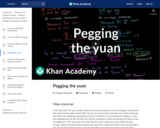
How the Chinese Central Bank could peg the Yuan to the dollar by printing Yuan and buying dollars (building up a dollar reserve). Created by Sal Khan.

Analysis of how well average inflation-adjusted after-tax income for the bottom 90% has tracked per capital GDP over the past 70 years. Created by Sal Khan.
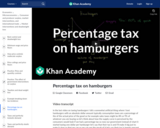
What would happen if we have a percentage tax instead of a fixed dollar amount. Created by Sal Khan.
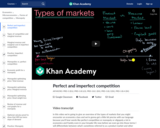
The most common forms of competition you learn about in microeconomics are perfect competition, monopolies, oligopoly, monopsony, and monopolistic competition. In this video we briefly describe the key features of each.